CO2 Methanation over Ni-Based Catalysts: Investigation of Mixed Silica/MgO Support Materials
Abstract
1. Introduction
2. Mechanisms of CO2 Methanation on SiO2 and MgO Support Materials
2.1. SiO2 as a Catalyst Support
2.2. MgO as a Catalyst Support
3. Results and Discussion
3.1. Catalyst Characterization
3.2. CO2 Methanation over Ni-Based Catalysts on Silica and Mixed SiO2/MgO Support
3.2.1. Commercial Silica
3.2.2. Rice Husk Silica
3.2.3. Comparison of Commercial Silica and Rice Husk Silica as Support
3.2.4. Mixed Rice Husk Silica and Magnesium Oxide Support
3.2.5. Comparison of Different Support Materials: SiO2(RH), SiO2(RH)/MgO, MgO, and MgO/sideritereduced
3.2.6. Characterization of Silica from Rice Husks as Catalyst Support and Ni-Based Catalysts Ni/SiO2(RH) and Ni/SiO2(RH)/MgO
3.2.7. Evaluation of Long-Term Stability of Ni/MgO and Ni/SiO2(RH) Catalysts
4. Materials and Methods
4.1. Raw Materials and Chemicals
4.2. Catalyst Preparation
4.2.1. Preparation of the Support Material
- (i)
- Silica support (rice husks): The rice husk was washed with deionized water to remove impurities, and, subsequently, it was dried overnight at 383 K in an air oven. Acid leaching was conducted by refluxing the cleaned dry rice husk in a solution of HCl (molar concentration of 0.5 mol·L−1) at 353 K for two hours. The procedure was carried out in a round bottom flask equipped with a heating mantle, magnetic stirrer, and reflux condenser. The stirring rate was 450 rpm, and the solid-to-liquid ratio was 0.1. Following filtration, the rice husk was rinsed with deionized water until pH reached 7 and then dried overnight at room temperature. Finally, it was further dried and calcined in a muffle furnace (Heraeus M 110) at 383 K for four hours and 873 K for two hours in order to obtain pure amorphous white silica as shown in Figure 15. The procedure was adapted from [68].
- (ii)
- Reduced siderite ore support (as described in [39]): In a previous study, original siderite ore was reduced in a hydrogen atmosphere consisting of 90% hydrogen (with a feed gas ratio of H2:N2 = 9:1 (v/v)) at a flow rate of 0.048 m3·h−1 in a tubular reactor at 973 K until the composition of the exit gas equaled that of the feed gas. Subsequently, the reduced siderite ore (sideritereduced) was exposed to ambient air at room temperature, resulting in partial reoxidation.
- (iii)
- Magnesium oxide support: Magnesium carbonate (4MgCO3·Mg(OH)2·4H2O) powder was calcined in a muffle furnace (Heraeus M 110) with air at 723 K for two hours, followed by an additional calcination at 823 K for five hours.
4.2.2. Impregnation
4.2.3. Thermal Deposition
4.2.4. Activation/Reduction with Hydrogen
4.3. Catalyst Characterization Procedure
4.3.1. Transmission Electron Microscopy (TEM)
4.3.2. X-Ray Diffraction
4.3.3. X-Ray Fluorescence Spectrometry
4.3.4. Atomic Absorption Spectrometry
4.4. Experimental Setup and Experimental Procedure of the Methanation Experiments
4.4.1. Experimental Setup
4.4.2. Experimental Procedure
5. Conclusions
Author Contributions
Funding
Data Availability Statement
Acknowledgments
Conflicts of Interest
Abbreviations
| CO2 conversion | |
| CH4 selectivity | |
| Initial concentration of CO2 | |
| Concentration of species i exiting the reactor | |
| Volumetric expansion coefficient | |
| Molar feed fraction of CO2 | |
| a, b, c, d | Stoichiometric coefficients of the methanation reaction (CO2: a = −1, H2: b = −4, CH4: c = 1, and H2O: d = 2) |
| Concentrations of nitrogen and hydrogen exiting the reactor | |
| cP | Product concentrations (CH4 and CO) exiting the reactor |
References
- Yang, Z.; Kumari, S.; Alexandrova, A.N.; Sautet, P. Catalytic Activity of an Ensemble of Sites for CO2 Hydrogenation to Methanol on a ZrO2-on-Cu Inverse Catalyst. J. Am. Chem. Soc. 2025, 147, 15294–15306. [Google Scholar] [CrossRef] [PubMed]
- Zhang, B.; Huang, S.; Li, Y.; Shen, J.; Tian, X.; Ding, M. Highly dispersed Cu on hollow spherical CeO2: An efficient and stable catalyst for the RWGS reaction. Appl. Catal. B Environ. 2025, 366, 125003. [Google Scholar] [CrossRef]
- Chen, M.; Liu, L.; Chen, X.; Qin, X.; Zhang, J.; Xie, S.; Liu, F.; He, H.; Zhang, C. Sulfate residuals on Ru catalysts switch CO2 reduction from methanation to reverse water-gas shift reaction. Nat. Commun. 2024, 15, 9478. [Google Scholar] [CrossRef] [PubMed]
- Zhang, M.; Zhu, Y.; Yan, J.; Xie, J.; Yu, T.; Peng, M.; Zhao, J.; Xu, Y.; Li, A.; Jia, C.; et al. A Highly Active Molybdenum Carbide Catalyst with Dynamic Carbon Flux for Reverse Water-Gas Shift Reaction. Angew. Chem. Int. Ed. Engl. 2025, 64, e202418645. [Google Scholar] [CrossRef]
- Wei, W.; Jinlong, G. Methanation of carbon dioxide: An overview. Front. Chem. Sci. Eng. 2011, 5, 2–10. [Google Scholar] [CrossRef]
- Huynh, H.L.; Zhu, J.; Zhang, G.; Shen, Y.; Tucho, W.M.; Ding, Y.; Yu, Z. Promoting effect of Fe on supported Ni catalysts in CO2 methanation by in situ DRIFTS and DFT study. J. Catal. 2020, 392, 266–277. [Google Scholar] [CrossRef]
- Hao, W.; Vall, M.; Shi, Y.; Wang, Q.; Strømme, M.; Yan, X.; Cheung, O.; Li, R. Novel Ni/MgO Catalysts from Mesoporous MgCO3 for Highly Efficient CO Methanation: Effects of Al and Si Stabilization. ChemRxiv 2020. [Google Scholar] [CrossRef]
- Song, C.; Liu, J.; Wang, R.; Tang, X.; Wang, K.; Gao, Z.; Peng, M.; Li, H.; Yao, S.; Yang, F.; et al. Engineering MOx/Ni inverse catalysts for low-temperature CO2 activation with high methane yields. Nat. Chem. Eng. 2024, 1, 638–649. [Google Scholar] [CrossRef]
- Li, S.; Zhang, T.; Zheng, H.; Niu, J.; Zhang, W.; Ma, J.; Li, W.-W. Efficient photo-Fenton degradation of water pollutants via peracetic acid activation over sulfur vacancies-rich metal sulfides/MXenes. Appl. Catal. B Environ. 2025, 366, 125000. [Google Scholar] [CrossRef]
- Karelovic, A.; Ruiz, P. Improving the Hydrogenation Function of Pd/γ-Al2O3 Catalyst by Rh/γ-Al2O3 Addition in CO2 Methanation at Low Temperature. ACS Catal. 2013, 3, 2799–2812. [Google Scholar] [CrossRef]
- Kim, H.Y.; Lee, H.M.; Park, J.-N. Bifunctional mechanism of CO2 methanation on Pd-MgO/SiO2 catalyst: Independent roles of MgO and Pd on CO2 methanation. J. Phys. Chem. C 2010, 114, 7128–7131. [Google Scholar] [CrossRef]
- Jalama, K. Carbon dioxide hydrogenation over nickel-, ruthenium-, and copper-based catalysts: Review of kinetics and mechanism. Catal. Rev. 2017, 59, 95–164. [Google Scholar] [CrossRef]
- Beuls, A.; Swalus, C.; Jacquemin, M.; Heyen, G.; Karelovic, A.; Ruiz, P. Methanation of CO2: Further insight into the mechanism over Rh/γ-Al2O3 catalyst. Appl. Catal. B Environ. 2012, 113–114, 2–10. [Google Scholar] [CrossRef]
- Yuan, H.; Zhu, X.; Han, J.; Wang, H.; Ge, Q. Rhenium-promoted selective CO2 methanation on Ni-based catalyst. J. CO2 Util. 2018, 26, 8–18. [Google Scholar] [CrossRef]
- Struijs, J.J.C.; Muravev, V.; Verheijen, M.A.; Hensen, E.J.M.; Kosinov, N. Ceria-Supported Cobalt Catalyst for Low-Temperature Methanation at Low Partial Pressures of CO2. Angew. Chem. Int. Ed. Engl. 2023, 62, e202214864. [Google Scholar] [CrossRef]
- Li, M.; Amari, H.; van Veen, A.C. Metal-oxide interaction enhanced CO2 activation in methanation over ceria supported nickel nanocrystallites. Appl. Catal. B Environ. 2018, 239, 27–35. [Google Scholar] [CrossRef]
- Ren, J.; Guo, H.; Yang, J.; Qin, Z.; Lin, J.; Li, Z. Insights into the mechanisms of CO2 methanation on Ni(111) surfaces by density functional theory. Appl. Surf. Sci. 2015, 351, 504–516. [Google Scholar] [CrossRef]
- Aziz, M.A.A.; Jalil, A.A.; Triwahyono, S.; Ahmad, A. CO2 methanation over heterogeneous catalysts: Recent progress and future prospects. Green Chem. 2015, 17, 2647–2663. [Google Scholar] [CrossRef]
- Meloni, E.; Cafiero, L.; Renda, S.; Martino, M.; Pierro, M.; Palma, V. Ru- and Rh-Based Catalysts for CO2 Methanation Assisted by Non-Thermal Plasma. Catalysts 2023, 13, 488. [Google Scholar] [CrossRef]
- Jiang, X.; Nie, X.; Guo, X.; Song, C.; Chen, J.G. Recent advances in carbon dioxide hydrogenation to methanol via heterogeneous catalysis. Chem. Rev. 2020, 120, 7984–8034. [Google Scholar] [CrossRef]
- Garbarino, G.; Bellotti, D.; Riani, P.; Magistri, L.; Busca, G. Methanation of carbon dioxide on Ru/Al2O3 and Ni/Al2O3 catalysts at atmospheric pressure: Catalysts activation, behaviour and stability. Int. J. Hydrogen Energy 2015, 40, 9171–9182. [Google Scholar] [CrossRef]
- Memon, M.; Jiang, Y.; Hassan, M.; Ajmal, M.; Wang, H.; Liu, Y. Heterogeneous Catalysts for Carbon Dioxide Methanation: A View on Catalytic Performance. Catalysts 2023, 13, 1514. [Google Scholar] [CrossRef]
- Franken, T.; Heel, A. Are Fe based catalysts an upcoming alternative to Ni in CO2 methanation at elevated pressure? J. CO2 Util. 2020, 39, 101175. [Google Scholar] [CrossRef]
- González-Castaño, M.; Navarro de Miguel, J.C.; Boelte, J.-H.; Centeno, M.A.; Klepel, O.; Arellano-García, H. Assessing the impact of textural properties in Ni–Fe catalysts for CO2 methanation performance. Microporous Mesoporous Mater. 2021, 327, 111405. [Google Scholar] [CrossRef]
- Kirchner, J.; Anolleck, J.K.; Lösch, H.; Kureti, S. Methanation of CO2 on iron based catalysts. Appl. Catal. B Environ. 2018, 223, 47–59. [Google Scholar] [CrossRef]
- Tu, J.; Wu, H.; Qian, Q.; Han, S.; Chu, M.; Jia, S.; Feng, R.; Zhai, J.; He, M.; Han, B. Low temperature methanation of CO2 over an amorphous cobalt-based catalyst. Chem. Sci. 2021, 12, 3937–3943. [Google Scholar] [CrossRef]
- Champon, I.; Bengaouer, A.; Chaise, A.; Thomas, S.; Roger, A.-C. Carbon dioxide methanation kinetic model on a commercial Ni/Al2O3 catalyst. J. CO2 Util. 2019, 34, 256–265. [Google Scholar] [CrossRef]
- Takezawa, N.; Terunuma, H.; Shimokawabe, M.; Kobayashib, H. Methanation of carbon dioxide: Preparation of Ni/MgO catalysts and their performance. Appl. Catal. 1986, 23, 291–298. [Google Scholar] [CrossRef]
- Tada, S.; Shimizu, T.; Kameyama, H.; Haneda, T.; Kikuchi, R. Ni/CeO2 catalysts with high CO2 methanation activity and high CH4 selectivity at low temperatures. Int. J. Hydrogen Energy 2012, 37, 5527–5531. [Google Scholar] [CrossRef]
- Ge, F.; Zhu, J.; Du, X.; Wang, P.; Chen, Y.; Zhuang, W.; Song, M.; Sun, L.; Tao, X.; Li, J.; et al. Constructing the highly efficient Ni/ZrO2/SiO2 catalyst by a combustion-impregnation method for low-temperature CO2 methanation. J. Environ. Chem. Eng. 2022, 10, 108476. [Google Scholar] [CrossRef]
- Xu, Y.; Wan, H.; Du, X.; Yao, B.; Wei, S.; Chen, Y.; Zhuang, W.; Yang, H.; Sun, L.; Tao, X.; et al. Highly active Ni/CeO2/SiO2 catalyst for low-temperature CO2 methanation: Synergistic effect of small Ni particles and optimal amount of CeO2. Fuel Process. Technol. 2022, 236, 107418. [Google Scholar] [CrossRef]
- Shen, L.; Xu, J.; Zhu, M.; Han, Y.-F. Essential Role of the Support for Nickel-Based CO2 Methanation Catalysts. ACS Catal. 2020, 10, 14581–14591. [Google Scholar] [CrossRef]
- Weber, S.; Abel, K.L.; Zimmermann, R.T.; Huang, X.; Bremer, J.; Rihko-Struckmann, L.K.; Batey, D.; Cipiccia, S.; Titus, J.; Poppitz, D.; et al. Porosity and Structure of Hierarchically Porous Ni/Al2O3 Catalysts for CO2 Methanation. Catalysts 2020, 10, 1471. [Google Scholar] [CrossRef]
- Rahmani, S.; Rezaei, M.; Meshkani, F. Preparation of highly active nickel catalysts supported on mesoporous nanocrystalline γ-Al2O3 for CO2 methanation. J. Ind. Eng. Chem. 2014, 20, 1346–1352. [Google Scholar] [CrossRef]
- Gac, W.; Zawadzki, W.; Rotko, M.; Greluk, M.; Słowik, G.; Kolb, G. Effects of support composition on the performance of nickel catalysts in CO2 methanation reaction. Catal. Today 2020, 357, 468–482. [Google Scholar] [CrossRef]
- Varun, Y.; Sreedhar, I.; Singh, S.A. Highly stable M/NiO–MgO (M = Co, Cu and Fe) catalysts towards CO2 methanation. Int. J. Hydrogen Energy 2020, 45, 28716–28731. [Google Scholar] [CrossRef]
- Loder, A.; Siebenhofer, M.; Lux, S. The reaction kinetics of CO2 methanation on a bifunctional Ni/MgO catalyst. J. Ind. Eng. Chem. 2020, 85, 196–207. [Google Scholar] [CrossRef]
- Wang, G.; Xu, S.; Jiang, L.; Wang, C. Nickel supported on iron-bearing olivine for CO2 methanation. Int. J. Hydrogen Energy 2016, 41, 12910–12919. [Google Scholar] [CrossRef]
- Suksumrit, K.; Hauzenberger, C.A.; Santitharangkun, S.; Lux, S. Reduced Siderite Ore Combined with Magnesium Oxide as Support Material for Ni-Based Catalysts; An Experimental Study on CO2 Methanation. Catalysts 2024, 14, 206. [Google Scholar] [CrossRef]
- Serrer, M.-A.; Gaur, A.; Jelic, J.; Weber, S.; Fritsch, C.; Clark, A.H.; Saraçi, E.; Studt, F.; Grunwaldt, J.-D. Structural dynamics in Ni–Fe catalysts during CO2 methanation—Role of iron oxide clusters. Catal. Sci. Technol. 2020, 10, 7542–7554. [Google Scholar] [CrossRef]
- Luthfiah, A.; Deawati, Y.; Firdaus, M.L.; Rahayu, I.; Eddy, D.R. Silica from Natural Sources: A Review on the Extraction and Potential Application as a Supporting Photocatalytic Material for Antibacterial Activity. Sci. Technol. Indones. 2021, 6, 144–155. [Google Scholar] [CrossRef]
- Baker, R.T.K.; Tauster, S.J.; Dumesic, J.A. (Eds.) Strong Metal-Support Interactions; American Chemical Society: Washington, DC, USA, 1986; ISBN 9780841209558. [Google Scholar]
- Aziz, M.; Jalil, A.A.; Triwahyono, S.; Mukti, R.R.; Taufiq-Yap, Y.H.; Sazegar, M.R. Highly active Ni-promoted mesostructured silica nanoparticles for CO2 methanation. Appl. Catal. B Environ. 2014, 147, 359–368. [Google Scholar] [CrossRef]
- Azmi, A.A.; Aziz, M. Mesoporous adsorbent for CO2 capture application under mild condition: A review. J. Environ. Chem. Eng. 2019, 7, 103022. [Google Scholar] [CrossRef]
- Jiao, F.; Frei, H. Nanostructured Cobalt Oxide Clusters in Mesoporous Silica as Efficient Oxygen-Evolving Catalysts. Angew. Chem. 2009, 121, 1873–1876. [Google Scholar] [CrossRef]
- Guo, M.; Lu, G. The effect of impregnation strategy on structural characters and CO2 methanation properties over MgO modified Ni/SiO2 catalysts. Catal. Commun. 2014, 54, 55–60. [Google Scholar] [CrossRef]
- Vieira, J.L.; Destro, P.; Laier, L.O.; Marques, C.M.; Gallo, J.M.R.; Bueno, J.M.C. MgO/SiO2 prepared by wet-kneading as a catalyst for ethanol conversion to 1,3-butadiene: Prins condensation as the predominant mechanism. Mol. Catal. 2022, 532, 112718. [Google Scholar] [CrossRef]
- Guo, M.; Lu, G. The difference of roles of alkaline-earth metal oxides on silica-supported nickel catalysts for CO2 methanation. RSC Adv. 2014, 4, 58171–58177. [Google Scholar] [CrossRef]
- Taherian, Z.; Khataee, A.; Orooji, Y. Promoted nickel-based catalysts on modified mesoporous silica support: The role of yttria and magnesia on CO2 methanation. Microporous Mesoporous Mater. 2020, 306, 110455. [Google Scholar] [CrossRef]
- Dias, Y.R.; Perez-Lopez, O.W. Carbon dioxide methanation over Ni-Cu/SiO2 catalysts. Energy Convers. Manag. 2020, 203, 112214. [Google Scholar] [CrossRef]
- Zhang, Y.; Chen, Y.; Liu, Q. Green synthesis of MCM-41 derived from renewable biomass and construction of VOx-Modified nickel phyllosilicate catalyst for CO2 methanation. Int. J. Hydrogen Energy 2021, 46, 32003–32016. [Google Scholar] [CrossRef]
- Zhang, X.; SUN, W.; CHU, W. Effect of glow discharge plasma treatment on the performance of Ni/SiO2 catalyst in CO2 methanation. J. Fuel Chem. Technol. 2013, 41, 96–101. [Google Scholar] [CrossRef]
- Gao, W.; Meng, X.; Jin, D.; Xu, B.; Dai, W.; Zhao, R.; Xin, Z. Polyol-pretreated SBA-16 supported Ni-Fe bimetallic catalyst applied in CO methanation at low temperature. Mol. Catal. 2021, 512, 111769. [Google Scholar] [CrossRef]
- Mihet, M.; Dan, M.; Barbu-Tudoran, L.; Lazar, M.D. CO2 Methanation Using Multimodal Ni/SiO2 Catalysts: Effect of Support Modification by MgO, CeO2, and La2O3. Catalysts 2021, 11, 443. [Google Scholar] [CrossRef]
- Roque-Malherbe, R.; Polanco-Estrella, R.; Marquez-Linares, F. Study of the Interaction between Silica Surfaces and the Carbon Dioxide Molecule. J. Phys. Chem. C 2010, 114, 17773–17787. [Google Scholar] [CrossRef]
- Zhao, Y.; Girelli, V.; Ersen, O.; Debecker, D.P. CO2 methanation with high-loading mesoporous Ni/SiO2 catalysts: Toward high specific activity and new mechanistic insights. J. Catal. 2023, 426, 283–293. [Google Scholar] [CrossRef]
- Raupp, G.B.; Dumesic, J.A. Adsorption of carbon monoxide, carbon dioxide, hydrogen, and water on titania surfaces with different oxidation states. J. Phys. Chem. 1985, 89, 5240–5246. [Google Scholar] [CrossRef]
- Lamotte, J.; Saur, O.; Lavalley, J.-C.; Busca, G.; Rossi, P.F.; Lorenzelli, V. Coadsorption of methanol and carbon dioxide on alumina. J. Chem. Soc. Faraday Trans. 1 1986, 82, 3019. [Google Scholar] [CrossRef]
- Zecchina, A.; Garrone, E.; Ghiotti, G.; Coluccia, S. Chemistry of silica supported chromium ions. II. One-ligand complexes. Adsorption of carbon monoxide, carbon dioxide, and pyridine. J. Phys. Chem. 1975, 79, 972–978. [Google Scholar] [CrossRef]
- Morterra, C.; Magnacca, G. A case study: Surface chemistry and surface structure of catalytic aluminas, as studied by vibrational spectroscopy of adsorbed species. Catal. Today 1996, 27, 497–532. [Google Scholar] [CrossRef]
- Huang, J.; Li, X.; Wang, X.; Fang, X.; Wang, H.; Xu, X. New insights into CO2 methanation mechanisms on Ni/MgO catalysts by DFT calculations: Elucidating Ni and MgO roles and support effects. J. CO2 Util. 2019, 33, 55–63. [Google Scholar] [CrossRef]
- Park, J.-N.; McFarland, E.W. A highly dispersed Pd–Mg/SiO2 catalyst active for methanation of CO2. J. Catal. 2009, 266, 92–97. [Google Scholar] [CrossRef]
- Korotkova, T.; Ksandopulo, S.; Donenko, A.; Bushumov, S.; Danilchenko, A. Physical Properties and Chemical Composition of the Rice Husk and Dust. Orient. J. Chem. 2016, 32, 3213–3219. [Google Scholar] [CrossRef]
- Baldauf-Sommerbauer, G.; Lux, S.; Aniser, W.; Bitschnau, B.; Letofsky-Papst, I.; Siebenhofer, M. Steady-state and controlled heating rate methanation of CO2 on Ni/MgO in a bench-scale fixed bed tubular reactor. J. CO2 Util. 2018, 23, 1–9. [Google Scholar] [CrossRef]
- Loder, A.; Siebenhofer, M.; Böhm, A.; Lux, S. Clean iron production through direct reduction of mineral iron carbonate with low-grade hydrogen sources; the effect of reduction feed gas composition on product and exit gas composition. Clean. Eng. Technol. 2021, 5, 100345. [Google Scholar] [CrossRef]
- Ye, R.; Ma, L.; Hong, X.; Reina, T.R.; Luo, W.; Kang, L.; Feng, G.; Zhang, R.; Fan, M.; Zhang, R.; et al. Boosting Low-Temperature CO2 Hydrogenation over Ni-based Catalysts by Tuning Strong Metal-Support Interactions. Angew. Chem. Int. Ed. Engl. 2024, 63, e202317669. [Google Scholar] [CrossRef]
- Hameed, G.; Goksu, A.; Merkouri, L.-P.; Penkova, A.; Reina, T.R.; Ruiz, S.C.; Duyar, M.S. Experimental optimization of Ni/P atomic ratio for nickel phosphide catalysts in reverse water-gas shift. J. CO2 Util. 2023, 77, 102606. [Google Scholar] [CrossRef]
- Bakar, R.A.; Yahya, R.; Gan, S.N. Production of High Purity Amorphous Silica from Rice Husk. Procedia Chem. 2016, 19, 189–195. [Google Scholar] [CrossRef]
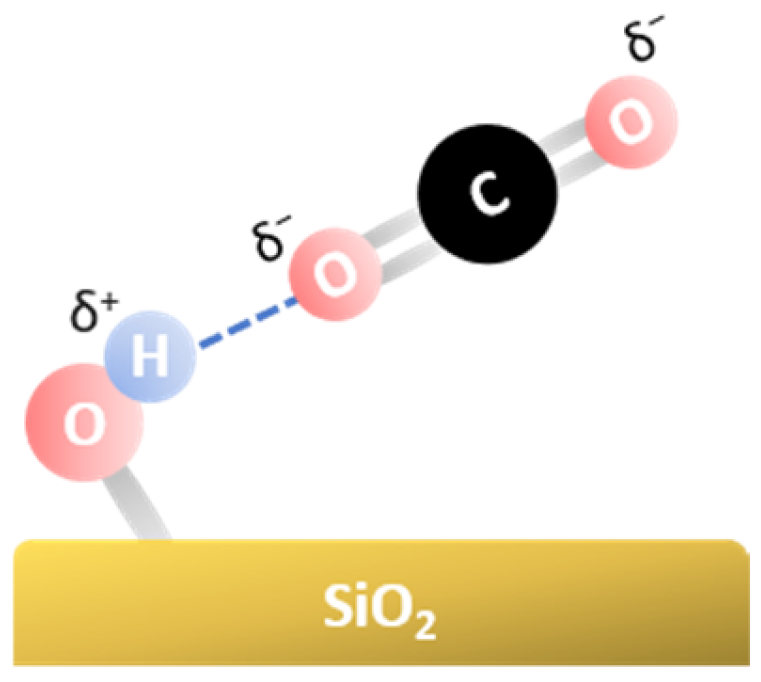
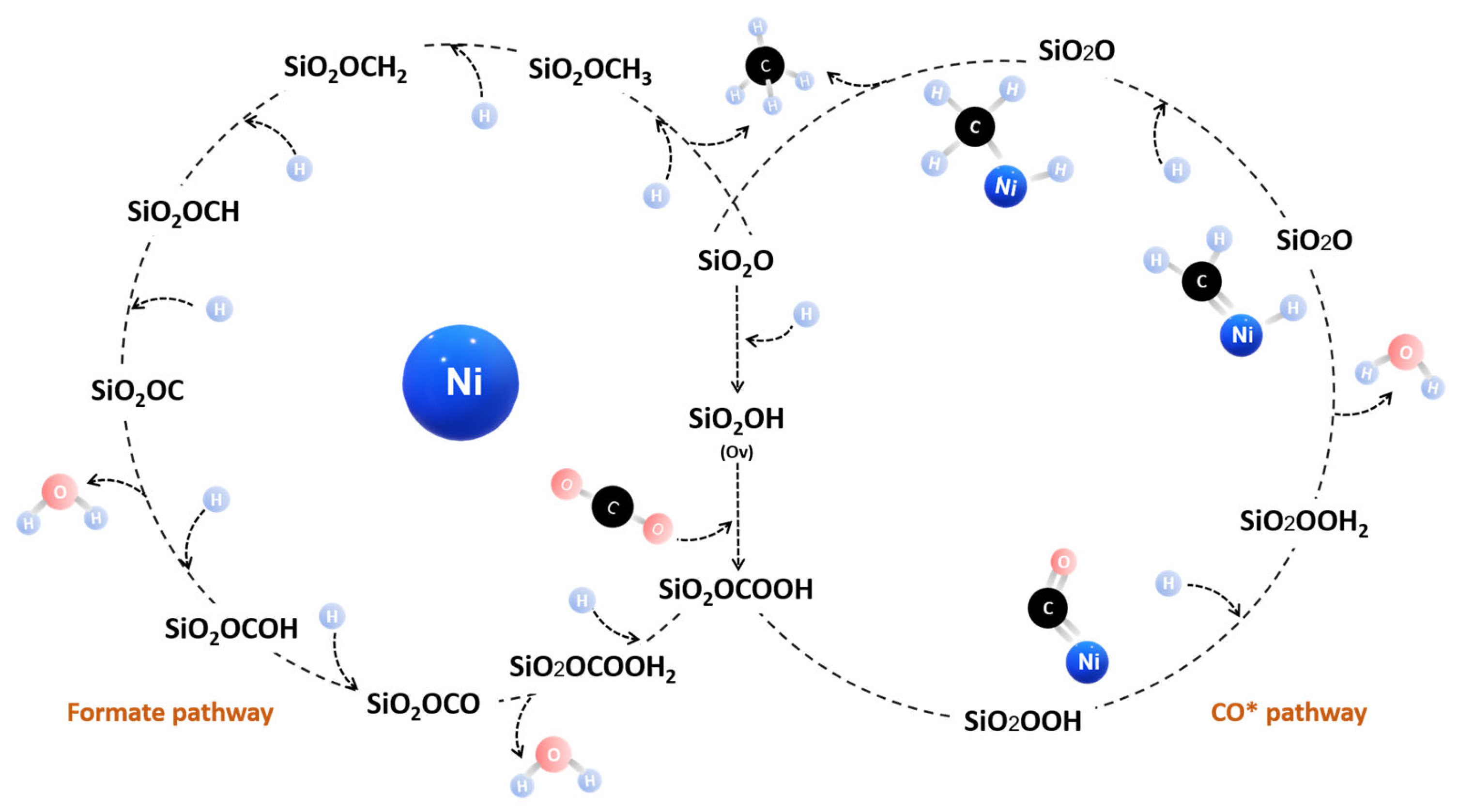

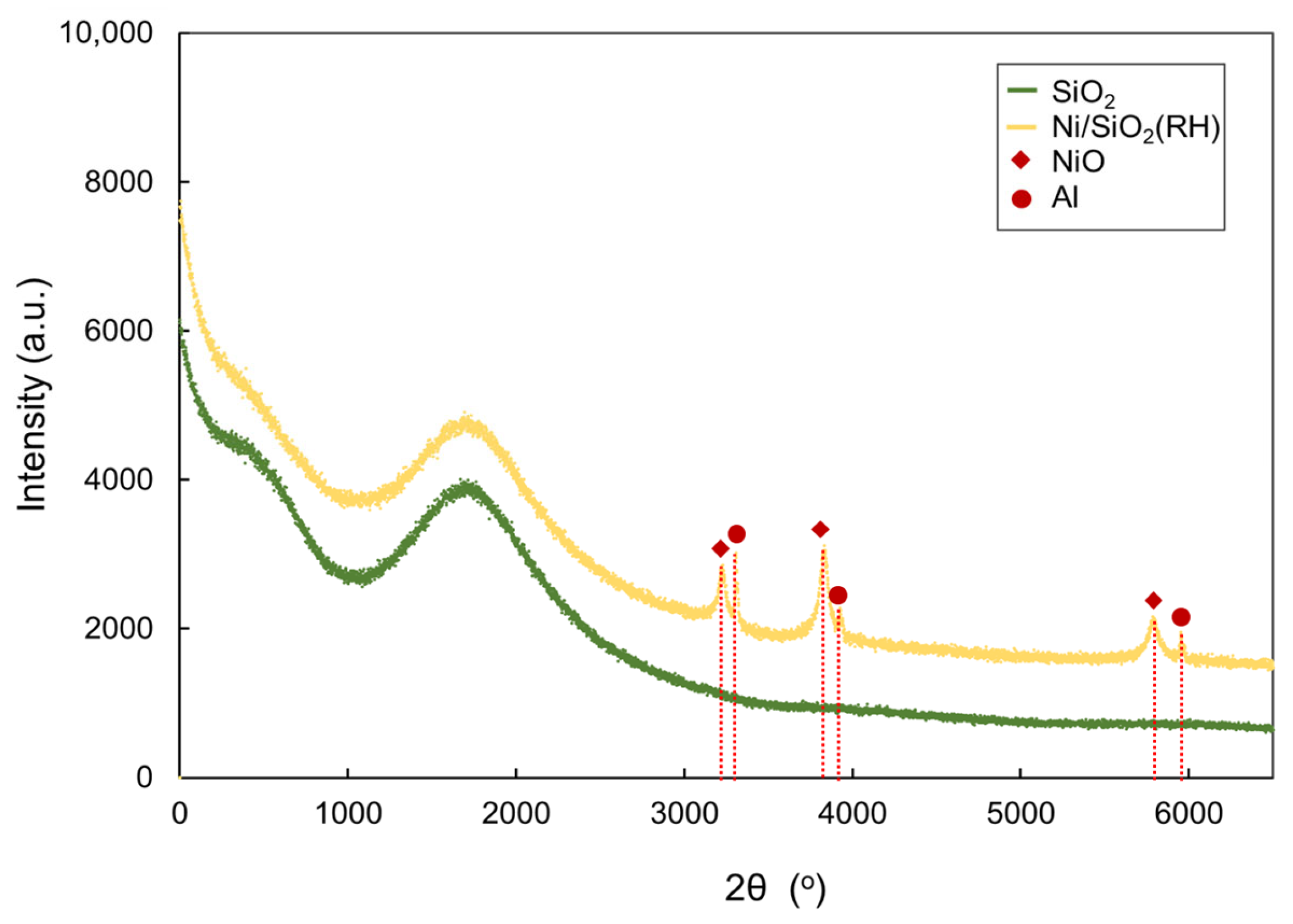
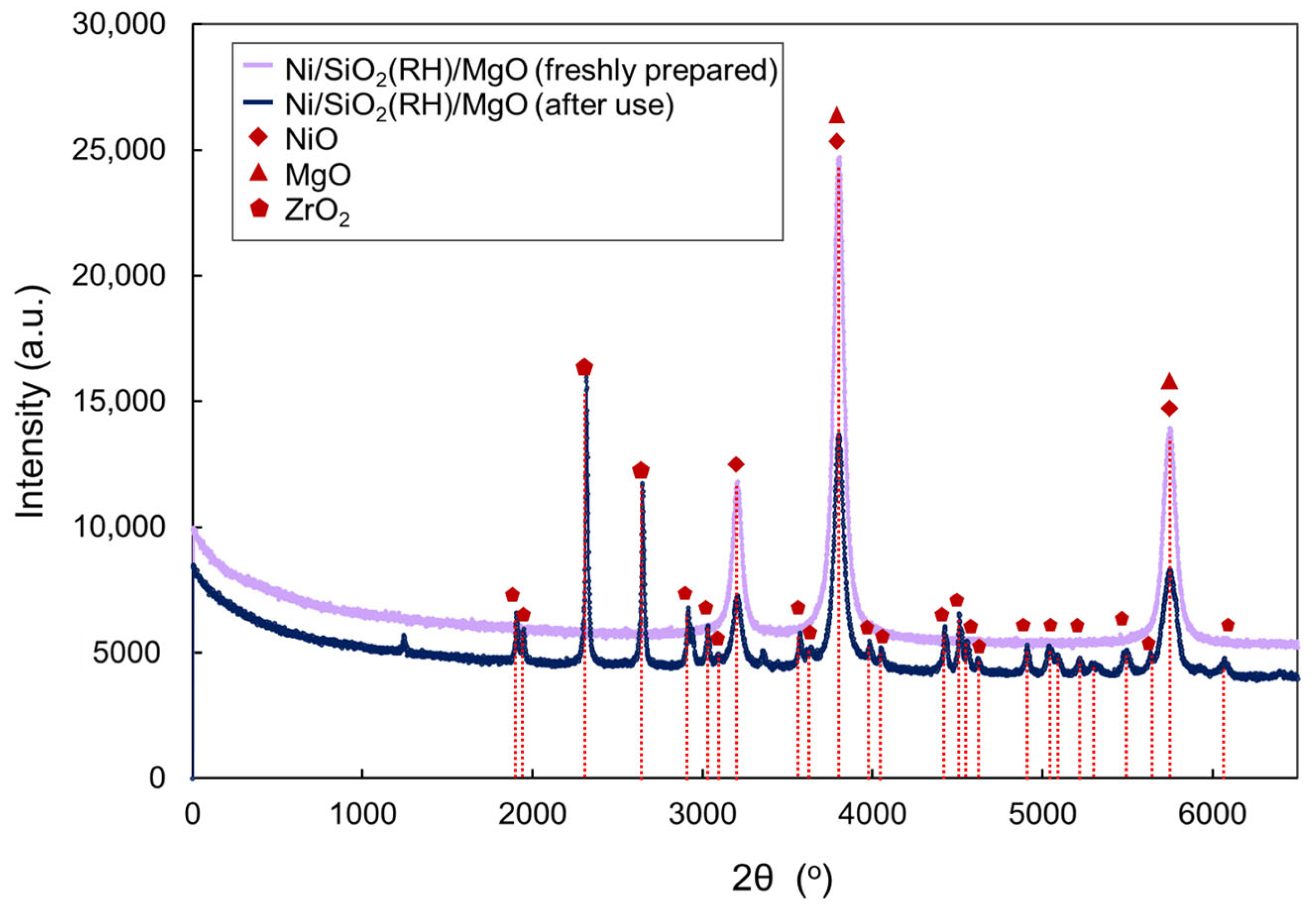
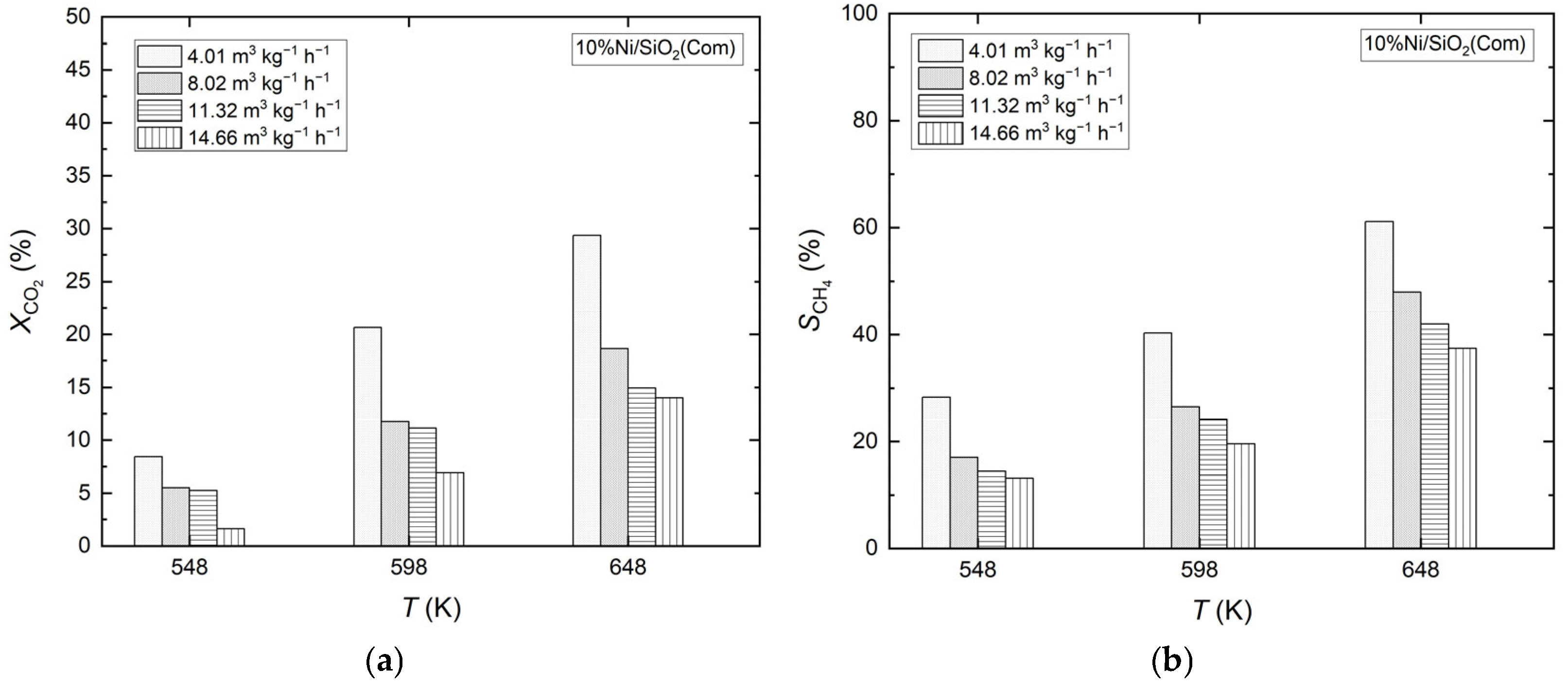

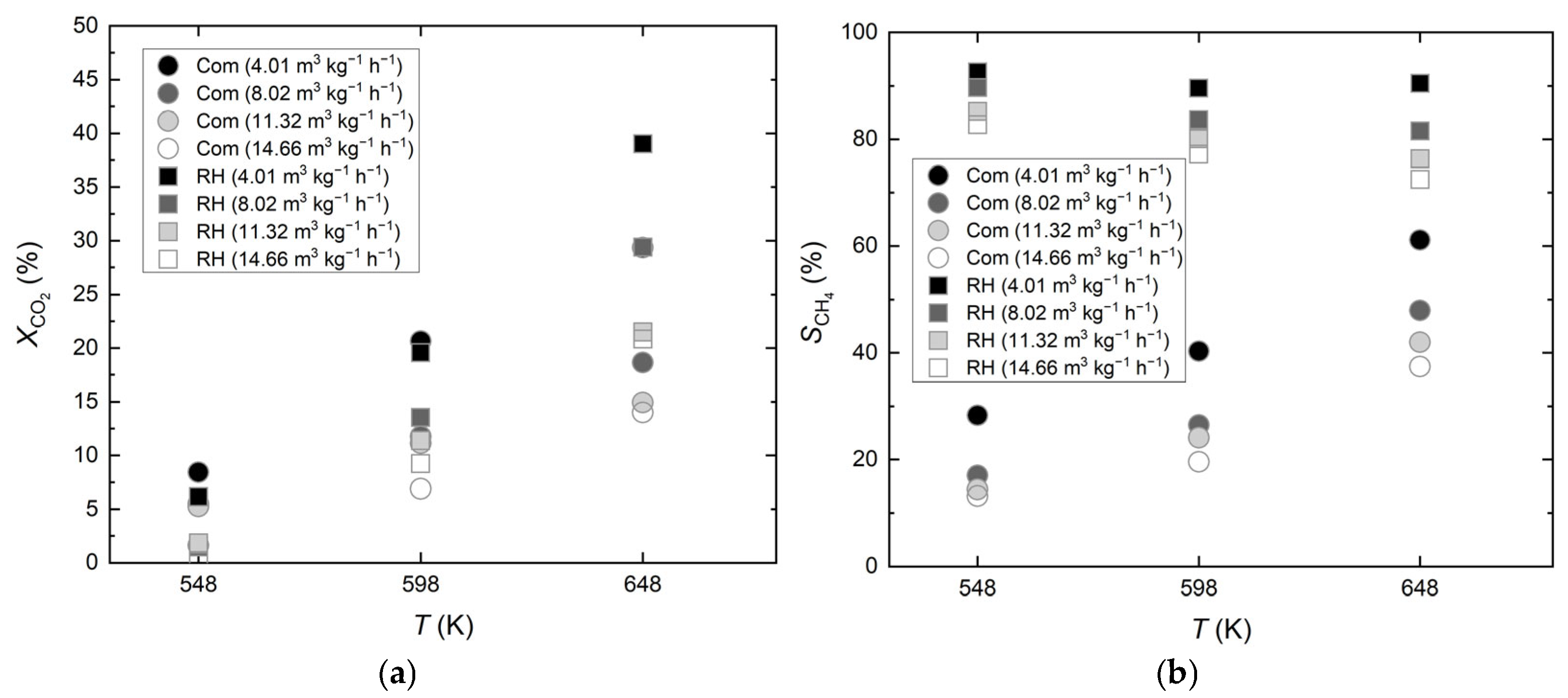
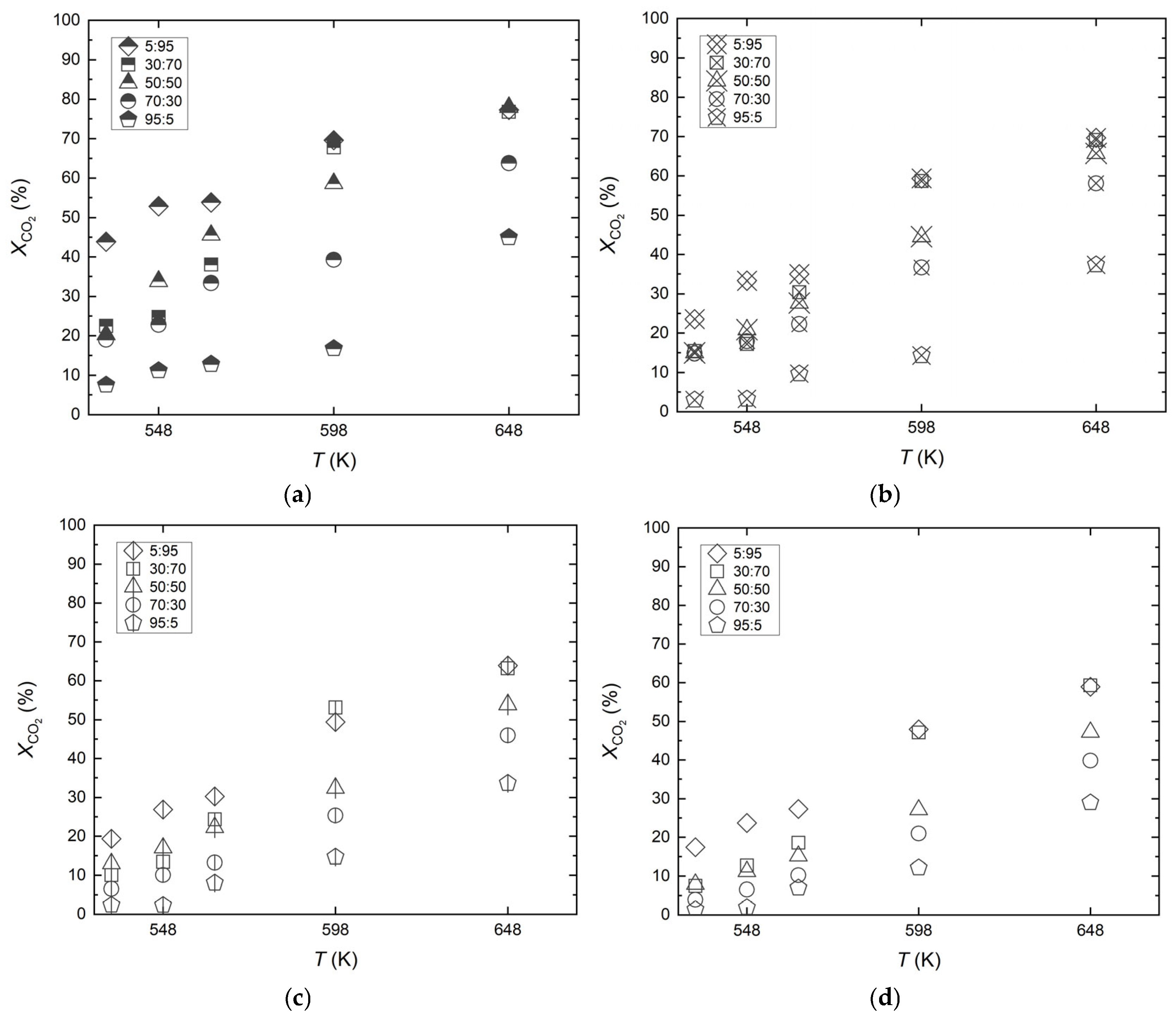
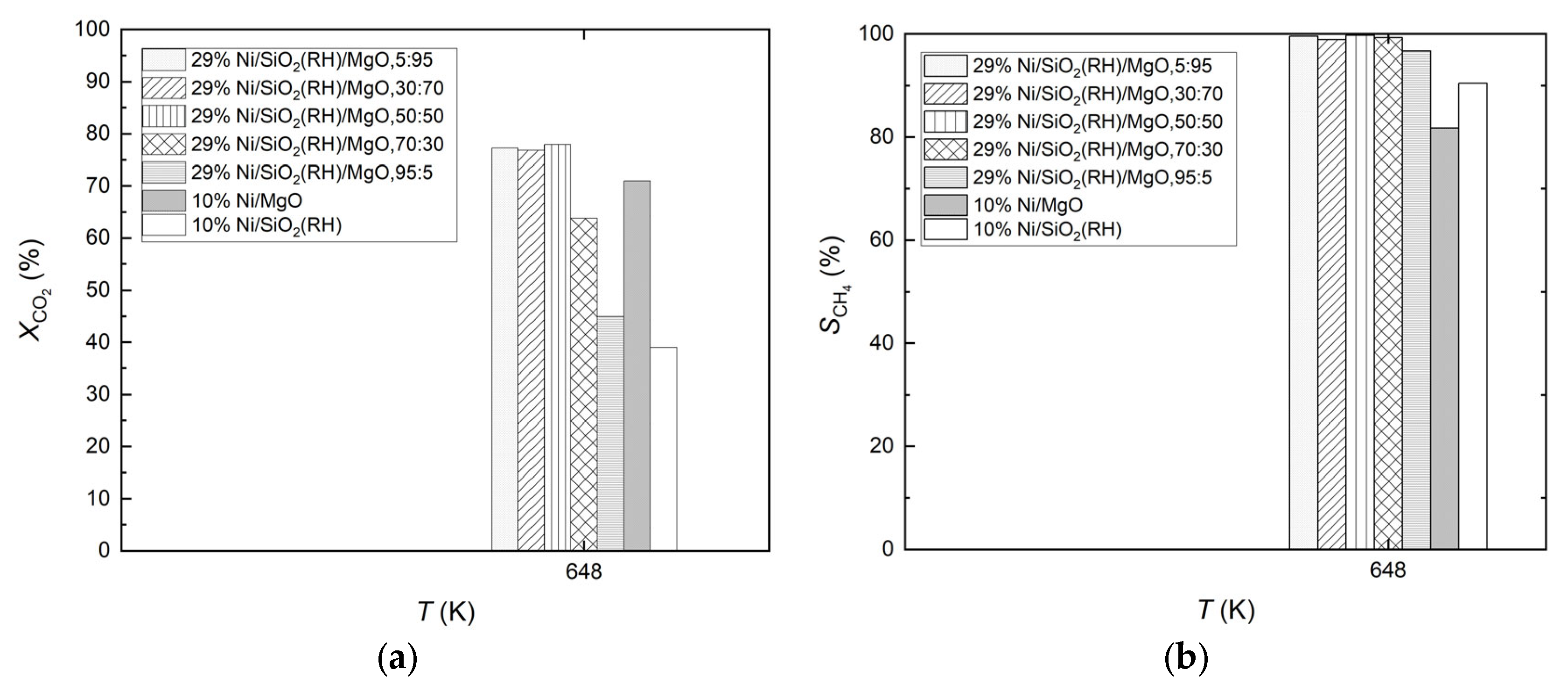

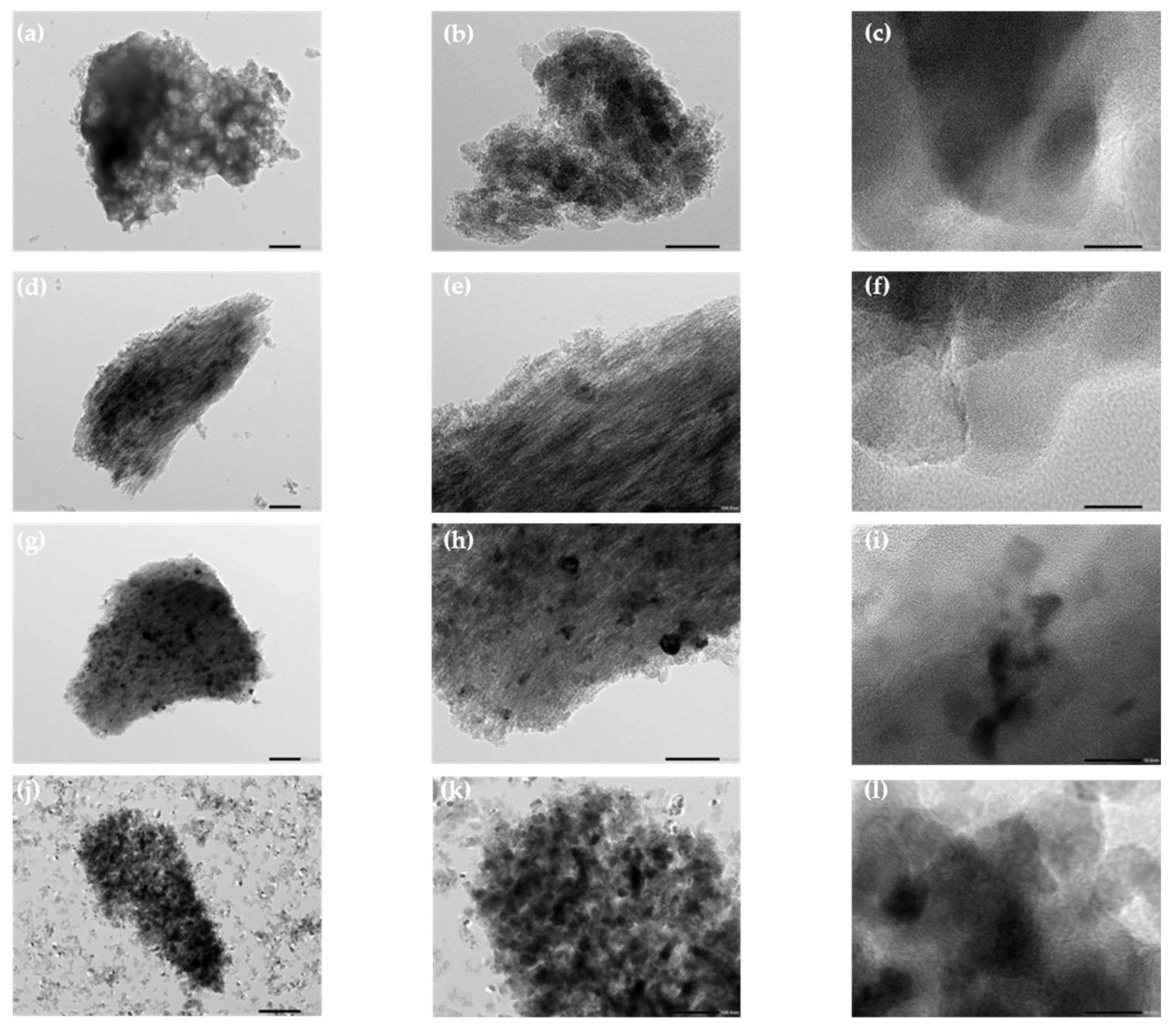
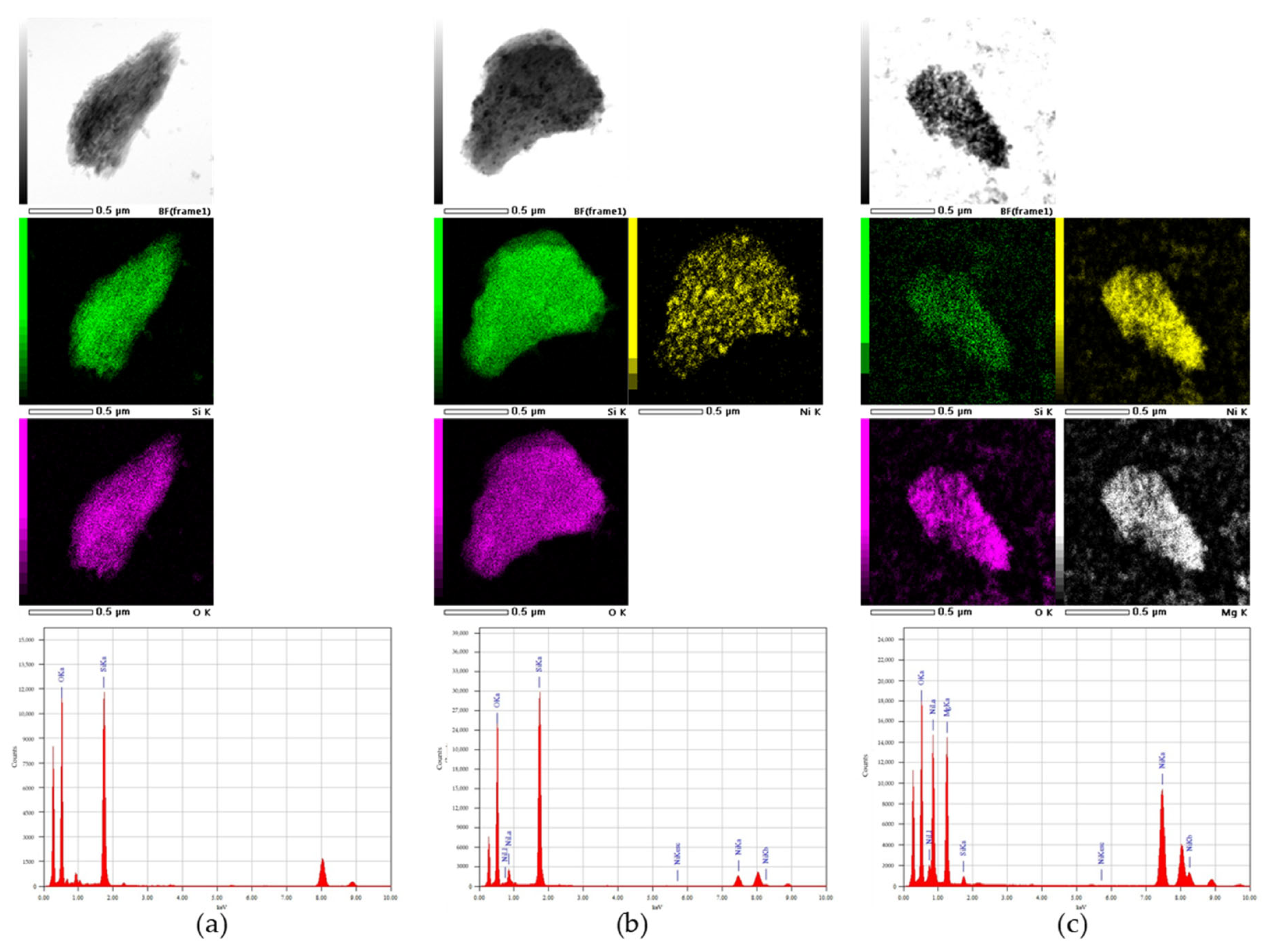
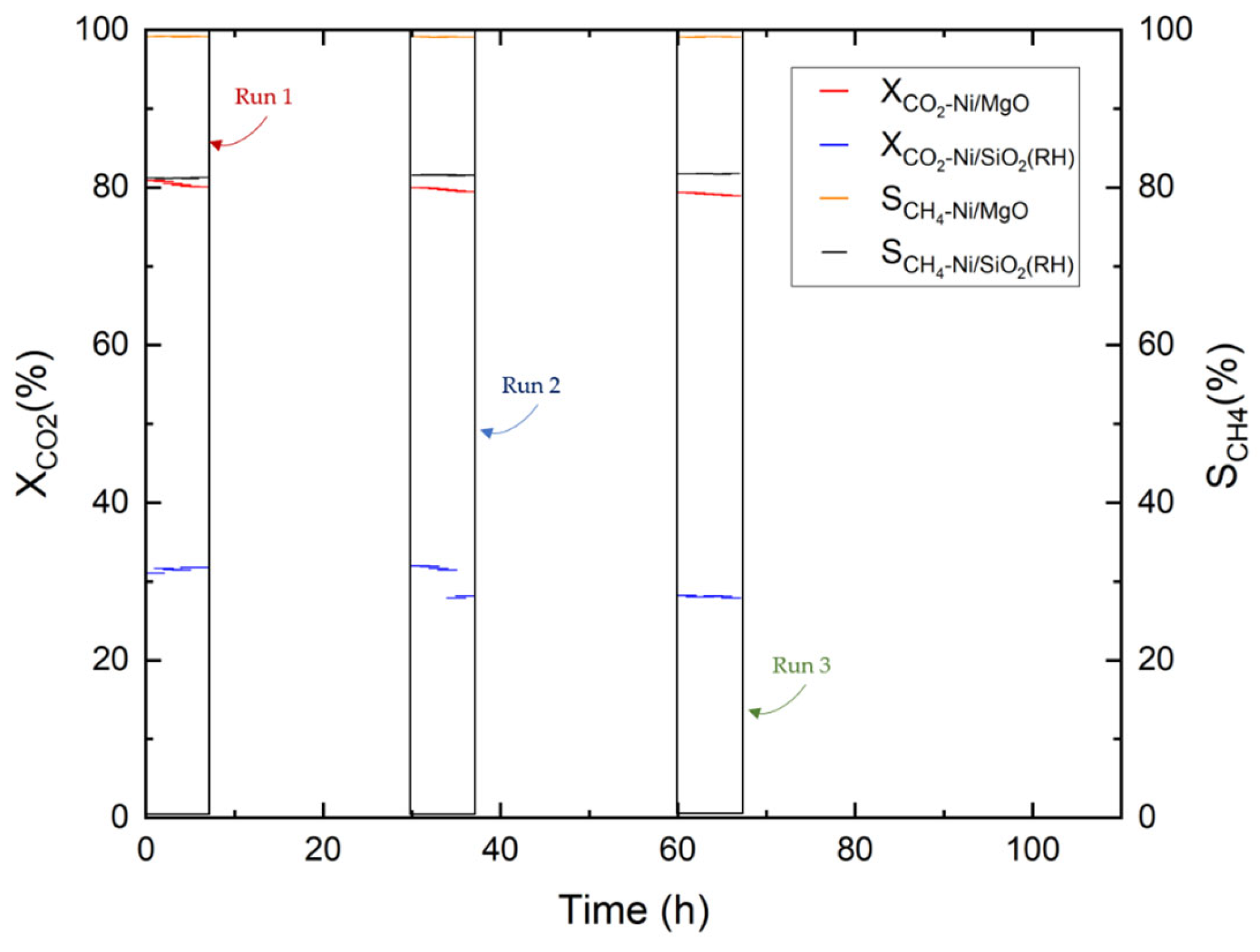
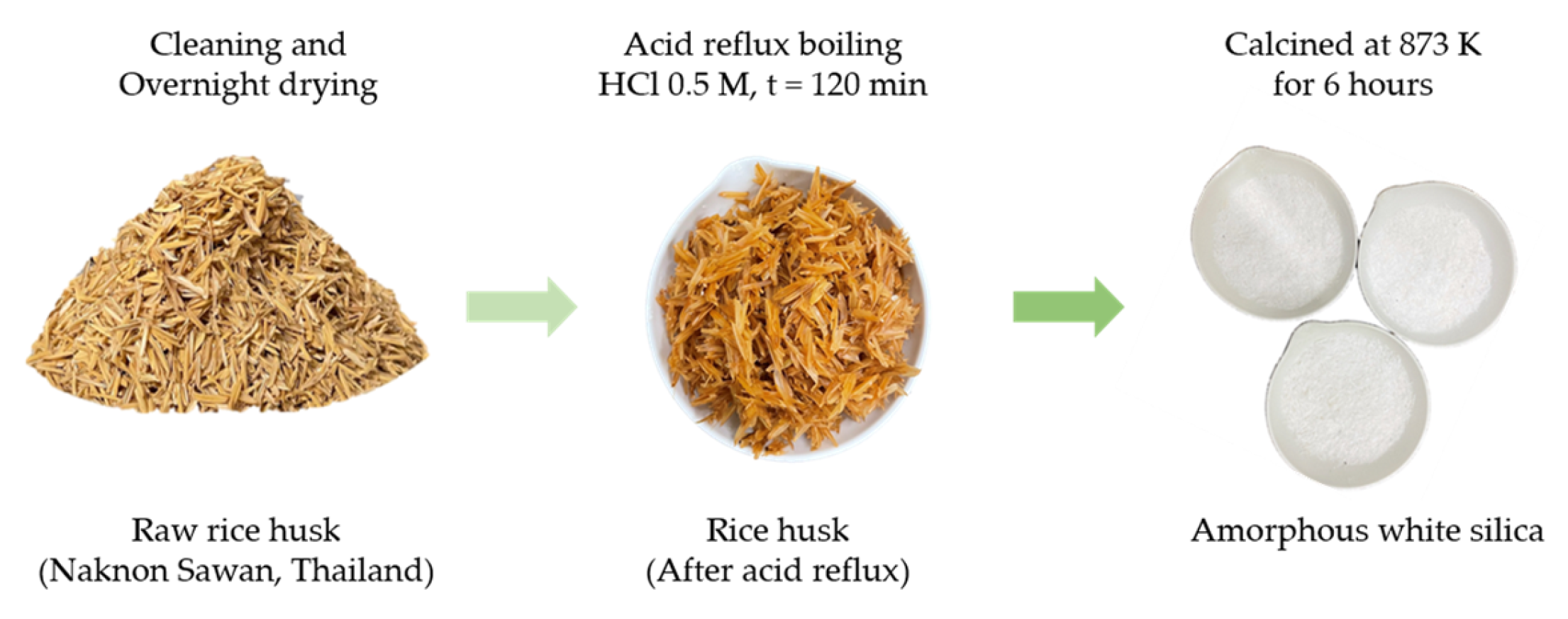


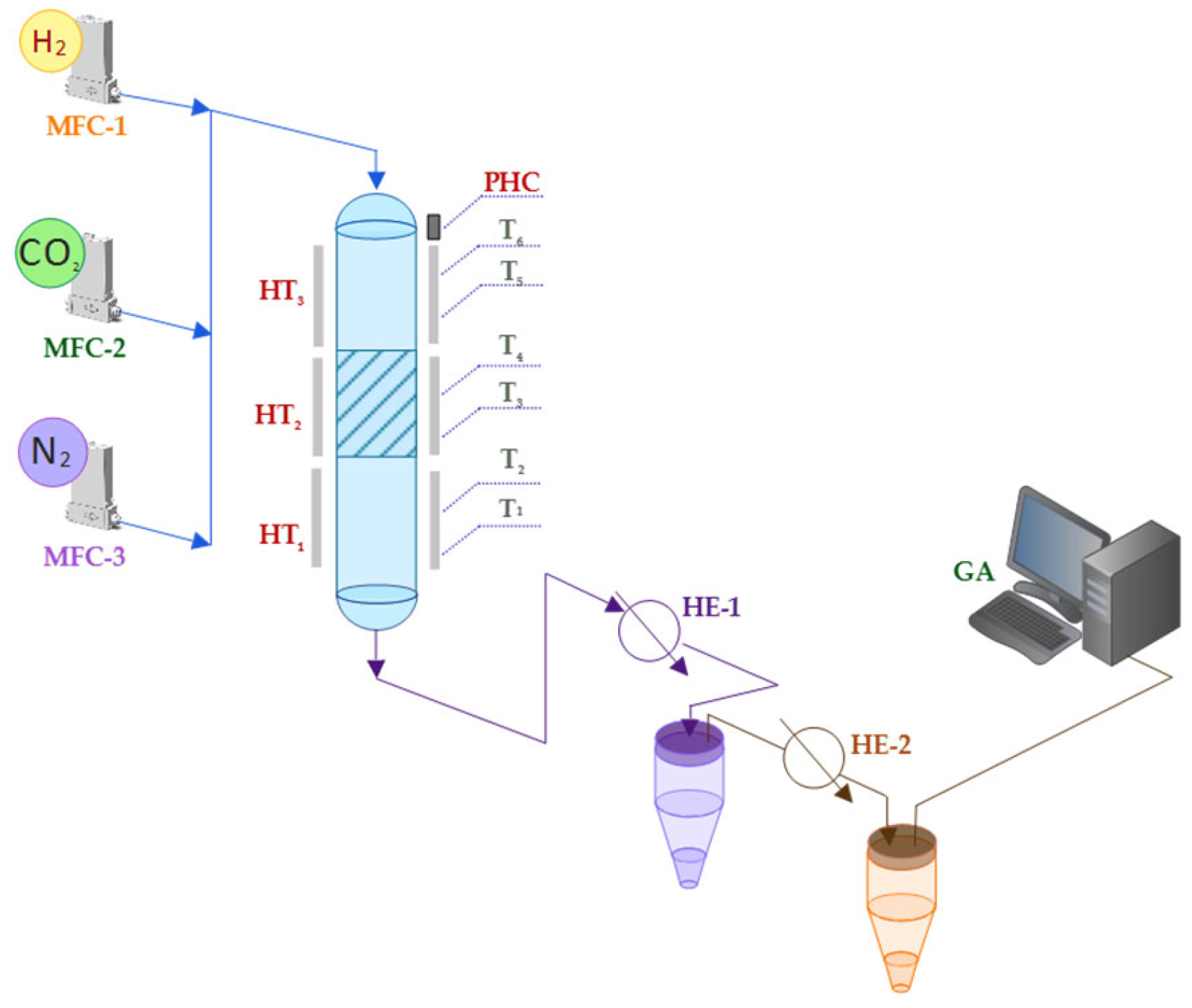
| Catalyst Composition | Preparation Method | Operation Conditions | Performance | Ref. |
|---|---|---|---|---|
| Ni/MgO (wNi = 0–27 wt%) | Wet impregnation | T = 533–648 K GHSV = 3.7 m3·kg−1·h−1 H2:CO2:N2 = 4:1:5 | = 87% = 99% | [37] |
| Ni-Fe/olivine ((MgxFe1−x)2 SiO4) | Wet impregnation | T = 673 K H2:CO2 = 6:1 GHSV = 11,000 h−1 | = 98% = 99% | [38] |
| 10% Ni-MgO/SiO2 (wMgO = 1, 2, and 4 wt%) | Co-impregnation, sequential impregnation | T = 573–673 K H2:CO2 = 4:1 GHSV = 15,000 cm3·h−1·g−1 | = 23.9–66.5% = 91.7–96.8% | [46] |
| 10% Ni-MgO/SiO2 (wMgO = 4 wt%) | Sequential impregnation | T = 573–723 K H2:CO2 = 4:1 GHSV = 15,000 cm3·h−1·g−1 | = 8.7–62.0% = 87.1–90.1% | [48] |
| 2Y2O3-Ni/MgO-MCM-41 (wyttria = 2 wt%) | Direct synthesis | T = 473–873 K H2:CO2 = 4:1 GHSV = 9000 cm3·h−1·g−1 | = 65.55% = 84.44% | [49] |
| 1% Cu and 9–10% Ni/SiO2 | Wet impregnation | WHSV = 60,000 cm3·g−1·h−1 H2:CO2 = 4:1 | XCO2 = 39.5%, SCH4 = 44.4% at 673 K (1% Cu and 10% Ni/SiO2) | [50] |
| Ni/MCM-41 with VOx-modified | Impregnation method and treated by glow discharge plasma | T = 673 K WHSV = 60,000 cm3·g−1·h−1 | = 81.4% = 72.8% | [51] |
| Ni/SiO2 | Impregnation | T = 523 K | = 99% = 100% (decreased by 15.54% after 100 h) | [52] |
| Ni-Fe/S16 | Mesoporous silica molecular sieve | T = 473–573 K H2:CO:N2 = 3:1:1 WHSV = 15,000 cm3·g−1·h−1 | XCO = 100% (at 503 K) > 90% | [53] |
| 10% Ni/MgO-SiO2 | Successive impregnation | T = 423–623 K CO2:H2 = 1:5.2 GHSV = 4650 h−1 | ≈ 31–33% ≈ 85–87% (at 523 K) | [54] |
| 2Y2O3-Ni/MgO-MCM-41 | One-pot synthesis | T = 673 K H2:CO2 = 4:1 GHSV = 9 L·gcat−1·h−1 | = 65.55% = 84.44% | [49] |
| Raw Material Weight (g) | Silica Product (g) | Silica Yield (%) |
|---|---|---|
| 30.4 | 6.67 | 21.94 |
| 21.43 | 4.11 | 19.18 |
| Total silica | 10.78 | 20.56 |
| Composition | SiO2 | Lignin | Cellulose | Protein | Fat | Other Nutrients |
|---|---|---|---|---|---|---|
| wt% | 18.8–22.3 | 9–20 | 28–38 | 1.9–3.0 | 0.3–0.8 | 9.3–9.5 |
| Catalyst | Average Crystallite Size (nm) |
|---|---|
| Ni/SiO2(RH) | 10.3 |
| Ni/SiO2(RH)/MgO (freshly prepared) | 10.8 |
| Ni/SiO2(RH)//MgO (after use) | 12.2–13.0 * |
| tsteady-state (h) | tstorage (h) | Tcat (K) | (%) | (%) | |
|---|---|---|---|---|---|
| 10 wt% Ni/SiO2 (RH) | |||||
| Run 1 | 6 | 24 | 648 ± 1.4 | 31.57 | 81.74 ± 0.03 |
| Run 2 | 6 | 24 | 648 ± 1.2 | 30.52 | 81.53 ± 0.06 |
| Run 3 | 6 | 0 | 648 ± 1.5 | 28.09 | 81.21 ± 0.11 |
| 30 wt% Ni/MgO | |||||
| Run 1 | 6 | 24 | 648 ± 1.5 | 79.36 | 99.58 ± 0.21 |
| Run 2 | 6 | 24 | 648 ± 1.4 | 79.44 | 99.55 ± 0.20 |
| Run 3 | 6 | 0 | 648 ± 1.5 | 79.39 | 99.56 ± 0.20 |
| Component | wt% |
|---|---|
| SiO2 | 99.86 |
| TiO2 | 0.01 |
| Al2O3 | 0.07 |
| Fe2O3 | <0.05 |
| MnO | <0.05 |
| MgO | <0.05 |
| CaO | <0.05 |
| K2O | <0.05 |
| Na2O | <0.05 |
| P2O5 | 0.06 |
Disclaimer/Publisher’s Note: The statements, opinions and data contained in all publications are solely those of the individual author(s) and contributor(s) and not of MDPI and/or the editor(s). MDPI and/or the editor(s) disclaim responsibility for any injury to people or property resulting from any ideas, methods, instructions or products referred to in the content. |
© 2025 by the authors. Licensee MDPI, Basel, Switzerland. This article is an open access article distributed under the terms and conditions of the Creative Commons Attribution (CC BY) license (https://creativecommons.org/licenses/by/4.0/).
Share and Cite
Suksumrit, K.; Hauzenberger, C.A.; Gostencnik, M.; Lux, S. CO2 Methanation over Ni-Based Catalysts: Investigation of Mixed Silica/MgO Support Materials. Catalysts 2025, 15, 589. https://doi.org/10.3390/catal15060589
Suksumrit K, Hauzenberger CA, Gostencnik M, Lux S. CO2 Methanation over Ni-Based Catalysts: Investigation of Mixed Silica/MgO Support Materials. Catalysts. 2025; 15(6):589. https://doi.org/10.3390/catal15060589
Chicago/Turabian StyleSuksumrit, Kamonrat, Christoph A. Hauzenberger, Michael Gostencnik, and Susanne Lux. 2025. "CO2 Methanation over Ni-Based Catalysts: Investigation of Mixed Silica/MgO Support Materials" Catalysts 15, no. 6: 589. https://doi.org/10.3390/catal15060589
APA StyleSuksumrit, K., Hauzenberger, C. A., Gostencnik, M., & Lux, S. (2025). CO2 Methanation over Ni-Based Catalysts: Investigation of Mixed Silica/MgO Support Materials. Catalysts, 15(6), 589. https://doi.org/10.3390/catal15060589








